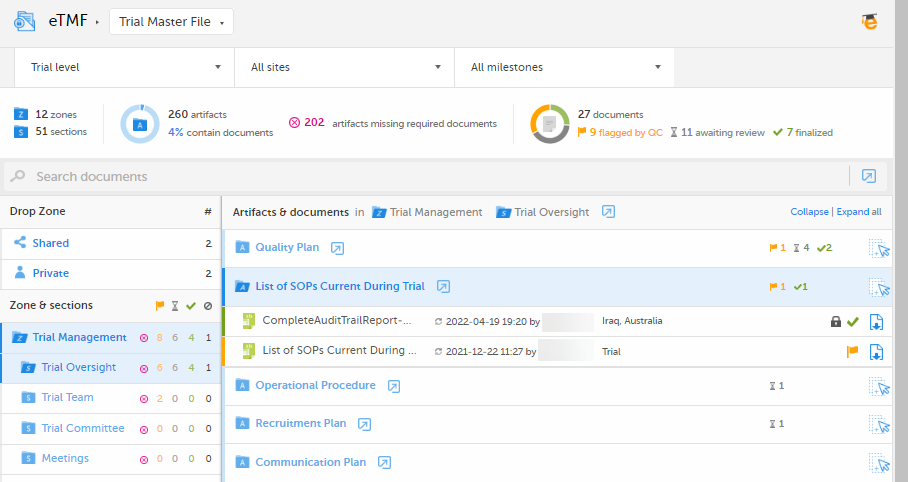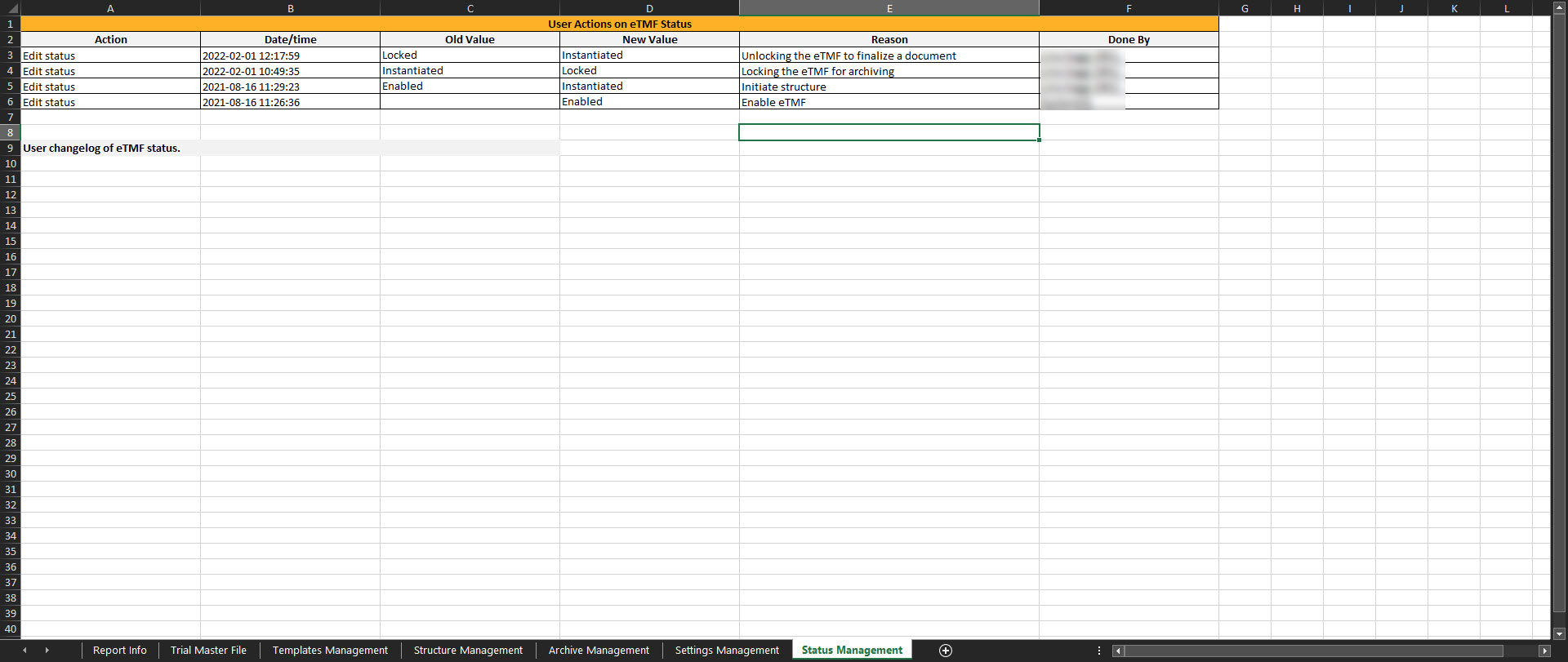TMF Archive
Complete audit trail report
Introduction
The complete audit trail report is in Excel format. It includes a complete list of actions done on:
- the structure, templates, and settings by the eTMF Managers
- the documents included in the TMF by the users
- generating and downloading the complete audit trail report and the TMF-EMS repository
The report respects the user roles and access to documents, sites, and countries.
Generating and downloading the report

To generate the complete audit trail report:
| 1 | Set the options (a) for the documents’ audit trails to be included. You can choose to include documents that are filed on trial/country/site levels according to your permissions to those. |
| 2 |
Set the milestones/milestone groups (b) you would like to filter by. Note! Artifacts that don't have milestones assigned will not be included when generating an audit trail report. To include the documents from artifacts that don't have an assigned milestone or milestone group, generate a separate audit trail report with this filter removed. |
| 3 | Click Generate. |
| 4 | Click on the generated document link to download the report (c). |
Included sheets
Each sheet in the complete audit trail report corresponds to the actions done by users on a certain view or section, as shown in the following table:
| Trial Master File |

|
| Templates Management |  |
| Structure Management |  |
| Archive Management |  |
| Settings Management |  |
| Status Management |  |
The report is self-explanatory, but in the following sections you can find detailed information about each sheet in the file:
Report Info
This sheet includes general information about the report and the study. The First document added date/time and Last document added date/time show when the first and last documents were uploaded to the TMF. This is shown regardless of whether the audit trail of these documents is included or not in the report.

Trial Master File
This sheet includes information about all the actions done by users on documents in the Trial Master File view. Note that the actions that are included in this sheet are done on:
- Published documents only.
- Documents that are linked to a level (Trial/Country/Site) that the user chose to include and are filed to an artifact that is linked to a milestone that the user has filtered by.
- Documents that the user has at least READ access to.

Sharing
This sheet includes information about all user actions on binders in Viedoc Share and Viedoc TMF.
Note! The sheet only include actions on the binders that the archivist has access to.

Templates Management
This sheet includes actions done by eTMF Managers on the templates. If the user doesn’t have access to TMF Admin view, this sheet is empty.

Structure Management
This sheet includes actions done by eTMF Managers on the instantiated structure. If the user doesn’t have access to TMF Admin, this sheet is empty.

Archive Management
This sheet includes this user actions done on the TMF Archive page.

Settings Management
This sheet includes the actions done by eTMF Managers on the Settings tab in TMF Admin. If the user doesn’t have access to TMF Admin, this sheet is empty.

Status management
This sheet includes the actions done by eTMF Managers on the Status tab in TMF Admin. If the user doesn't have access to to TMF Admin, this tab is empty.

eTMF-EMS repository
Introduction
The eTMF-EMS repository can be used for archiving the sponsor and/or investigator side of the study and/or exporting the documents that are included in the structure. It is compatible with the Exchange Mechanism Standard (EMS). Read more about the EMS here.
The eTMF-EMS repository respects the user roles and access to documents, sites, countries, and eTMF side.
Generating and downloading the EMS repository

To generate the repository:
| 1 |
Set the options (1) for the documents you want to include in the archive. You can choose to include documents that are filed to the investigator or sponsor side of the eTMF, and documents that are filed on trial/country/site levels according to your permissions to those. Note! Artifacts that are not assigned to a TMF side (sponsor or investigator) will not be extracted when generating a repository. To extract the documents from artifacts that don't have an assigned TMF side, generate a separate EMS repository with both of these filters removed. |
| 2 |
Set the milestones-milestone groups (2) you would like to filter by. Note! Artifacts that don't have milestones assigned will not be extracted when generating a repository. To extract the documents from artifacts that don't have an assigned milestone or milestone group, generate a separate EMS repository with this filter removed. |
| 3 | Click Generate (3). |
| 4 |
Click the generated document link to download the zipped folder (4). |
The zipped folder structure and content
The zipped folder structure mirrors the eTMF structure used for the study as follows:
- Level 1 – this level includes:
- The main zipped folder with a name in the format:
StudyName_eTMFArchive_DatetimeStampStudyName- the study nameeTMFArchive- static textDatetimeStamp- the UTC date and time of generating the eTMF-EMS repository in the formatYYYYmmDDHHMMss

- The main zipped folder with a name in the format:
- Level 2 – this level includes:
- A subfolder that has the name TransferID (datetime stamp of generating the eTMF-EMS repository) in the format
YYYYmmDDHHMMss - An exchange.xml file for each chosen milestone. You can read about the content of the xml files and find an example here
- A subfolder that has the name TransferID (datetime stamp of generating the eTMF-EMS repository) in the format

- Level 3 – this level includes:
- A folder with
ZoneID.ZoneNamefor each included zone from the structure
- A folder with

- Level 4 – this level includes:
- A folder with
ZoneID.SectionID.SectionNamefor each included section from the structure
- A folder with

- Level 5 – this level includes:
- A folder with
ZoneID.SectionID.ArtifactID.ArtifactNamefor each included artifact from the structure
- A folder with

- Level 6 – this level includes:
- Documents filed to this artifact on trial level
- A subfolder for signed documents*
- Subfolders for included countries with country code as their names

- Level 7 – this level includes:
- Documents filed to the artifact and linked to this specific country
- A subfolder for signed documents*
- Subfolders for sites in this country with site names as their names

- Level 8 – this level includes:
- A subfolder for signed documents*
- Documents filed to the artifact and linked to this specific site

*The files that are signed by Viedoc Me users are only included when archiving the Investigator side of the TMF.
The zipped folder includes all the versions of documents included in the structure. The name of the files will be as follows:
CurrentDocumentName-SystemVersion.extension, where:
CurrentDocumentNameis the latest document nameSystemVersionis the integer value of the version set by the system for this file
If there are multiple documents of the same name filed to the same artifact and linked to the same levels, the system will add (n) as a suffix to the document name to ensure that all files are included in the zipped folder and no files are overwritten.
